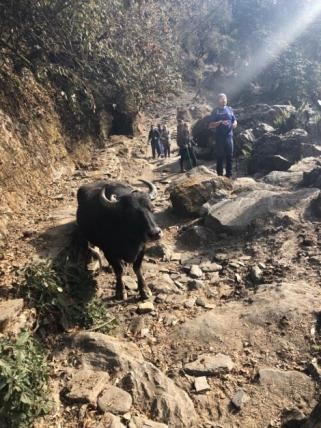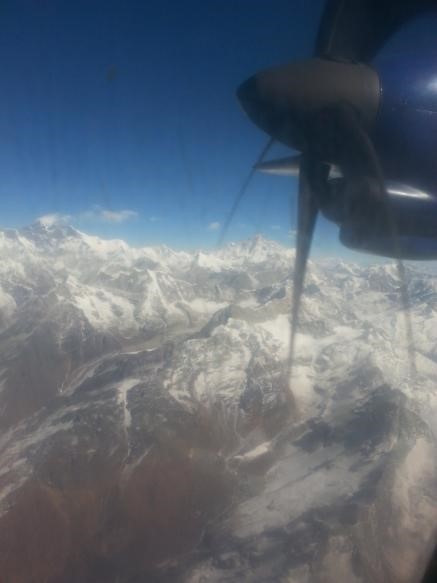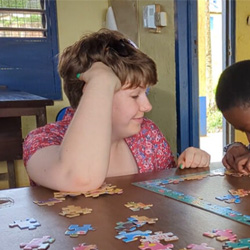What’s it like to volunteer in Nepal?
Sally Huggins joined VoluntEars in Nepal in January 2019 and wrote the following blog about her trip.
A CSW abroad – by Sally Huggins
I’d been looking at the organisation, VoluntEars, on and off for around a year. I was initially looking for something to do in the long college summer holidays and to help finger-tied hands on return to work in September.
I also thought it sounded a nice idea to be a trip Communicator, so I got on a train to Brighton to meet Richard Clowes, the Founder and Director, to find out what could be difficult about it. I’ll come back to that later.
I looked at the trips on offer and decided that Sri Lanka and Ghana would be too hot for me, so the Nepal trip in December /January would be the one to go for. It would be their winter, but still warm during the day.
In our group we had:
- One Deaf lady, my roommate, a BSL user
- One Deaf volunteer with a Cochlear Implant, he had very good oral skills and BSL as his first language, he could switch his voice on and off
- One hearing Volunteer, who wanted to reinforce her level 2 BSL and indulge her expensive hobby
- A young man, he was Deaf with a Cochlear, who had his own personal style of signing
- Myself, hearing and working as a CSW, who fancied a bit of holiday signing
- Our group Communicator, David. A freelance interpreter from the Sheffield area. He had been on two VoluntEars trips before
- Richard, the trip leader. He has Level 2 BSL

Sally with other volunteers at the Monkey Temple in Kathmandu, Nepal
It was a small group, but one with lots of different dynamics and opportunities for total communication; it would be really interesting to see how we would navigate each other and also how I would fit into the mix.
Richard and David were extremely professional, calm, focussed and not to be distracted from the job in hand. We would have a briefing every morning and evening and also before certain activities, like the renovation work at school. Often these sessions would open up a lot of questions for discussion. On day one I could see that interpreter David had his work cut out and I knew I would learn lots from him.
Our first trip was to Swaymbhunath – the Monkey Temple – in Kathmandu. Most of us wore a local accessory: the dust mask, which covered our mouths and hampered our oral communication somewhat.

Wearing masks because of the dust in Kathmandu!
This city was dusty and polluted but also bustling, colourful and a complete sensory experience. One of those experiences was taste and we had rice at almost every meal time. What do you expect…you’re in Asia!
On the morning we were leaving to Pokhara, our two Deaf lads sharing a room did not appear in the hotel lobby at the specified time. The bus journey would take six hours and there was only one bus a day. The hotel owner had to open their room with a spare key so we could wake up the boys and pack their stuff really quickly so we could still make the bus!
The main purpose of the trip was to help renovate a local Deaf school, located just outside Pokhara, where we stayed for the majority of the trip. Travelling on the School bus presented fabulous signing opportunities. We were crammed together with our faces inches from each other as we bumped along. How would I communicate with a seven year old Nepalese Deaf girl? She had a Cat’s Cradle string and it kept us both entertained for half an hour. We all adopted a sink or swim mind set and just had a go, somehow we all learned about each other’s cultures, families and lifestyles.

Taking the bus to school every morning near Pokhara
These school children were happy and beautifully turned out, the girl’s hair was always tied with ribbons. They loved communicating with us and trying to understand our BSL signs. They taught us their sign names in Nepalese. My own sign name (tea pot) was depicted as a gun hand shape shooting up from my mouth. It looked so much more cool than my UK version.
Before lessons the whole school lined up in rows in the playground exercising to the beat of a drum, followed by signing of their national anthem. What a delightful start to the day.

Morning exercises with students at a Deaf school in Nepal
On activity day I was unprepared to be handed a class of around 25 excitable children of varying ages. It was bedlam at first, until David helped me out by teaching me the sign for peace. We stood by the board and used topics such as sport and family, scribing and signing our versions and then the children took great pleasure responding in their sign language.

Sally and other volunteers take a class during the VoluntEars trip to Nepal
In an outdoor activity we formed a large circle and kicked a football to a student; they would then say a number, letter in sequence or a name beginning with a chosen letter and then chose a friend to kick to. This worked well and there were plenty of opportunities for speaking and listening while in possession of the ball!
During our welcome meeting David did a fantastic job of producing BSL while listening to a Nepali to English interpreter who was receiving information from the school Principle, Anita. I felt I was privileged in seeing the trip being brought to life by this visual language I am lucky enough to know and use in my job. Anita and the Nepalese students produced the most beautiful signing; it was like watching ballet but using your hands.

Being welcomed to the Deaf school in Nepal. David the Communicator interpreting the local sign language
Two of my favourite days were oddly enough, the long bus rides to and from the city to the mountains. The route was dusty, very bumpy and the toilet facilities en route were basic. However, it gave me time to reflect about myself on this adventure and to really soak it all in. I appreciated having that time to look around me and notice the local people, buildings and animals as we drove through the towns, villages, small holdings and past rivers. It would be difficult to explain when back at home, but instead of taking lots of photos and messaging people on my phone I decided to just be in the moment.
On the subject of communication, the wires system in Nepal (pictured) did cause a few power cuts, but they do have generators as a back up!

Cables…everywhere!
I had come to realise that that my job at home as a CSW involves what amounts to a series of short performances: I go to a job and sign for a set amount of time. I was now a member of a Deaf group and had to concentrate all the time on how to express myself visually, it was tiring. It made me think of the challenges a Deaf student must face all day at college.
On the middle weekend was the three day trek into the Himalayas with a climb up to 3,210 metres above sea level, which brought a new element to communication. Signing while trekking up and up to a higher altitude was a barrier to push through, I apologised for not being very sociable (signing or speaking) but it was all I could do at times to put one foot in front of the other and breathe.
Sometimes when our Deaf team mates were engaged in a sign chat, the hearing members of the group would speak in our first language and launch into the occasional show song to help us along the way. One of the tunes we adopted was New York, New York. We met a Water Buffalo on the way.

Meeting a water buffalo during the VoluntEars trek. We also met goats and monkeys!
We addressed other trekkers on the mountain with the greeting “Namaste” – this is sometimes used at the beginning of yoga classes at home. The Nepalese word for Thank you was Dhanyabaad…it sounded very much like “Dan…you’re bad” which was funny as our trekking guide was named Dan! A friend at home had lent me a lovely pair of real yak hair fingerless gloves with an over mitt attached. They looked the part, but with hindsight useless for signing and keeping my fingers warm at the same time!
With my own physical and mental endurances to overcome, suddenly the thought of being the trip Communicator didn’t seem so easy! Initially I had imagined myself being a possible link between the hearing and Deaf volunteers. I was wrong. I was too nervous to sign in front of David, it was challenging keeping up with three Deaf BSL users, at the school the students used Nepalese sign and the older ones knew ASL…I had no real knowledge of either. It was hard not to lapse into speech.

Our group at the start of the 3 day trek…amazing views!
Our Interpreter offered to pretend to fall asleep after dinner one evening while I took over the signing for the briefing for the next day, it was a break for him and I was ok as long he wasn’t watching! This really helped me get back into gear, I found the mechanics of signing kicked back in and started to flow again.
Sharing a room with my Deaf colleague was a brand new experience. When we closed the door at night, I had to carry on signing! We had a laugh, recalling some funny visual situations from the day’s activities. The idea that Deaf people live quiet lives is a myth…naturally they cannot hear themselves rustling bags, laughing on face time, slamming doors. I became her alarm clock in the morning, switching the lights on and off.
During the treks and walks around town, two things were confirmed to me about signing on the move
- It slows people down
- You are not as aware of your surroundings
The hearing members of our team didn’t seem to have acquired the same awareness of the environment, I think we were more likely to fall in a ditch or in the path of a motor cycle. Initially I found myself either stopping or walking backwards every time I wanted to sign to someone.
We were running late one day and the group had to try hard not to talk for a few minutes; otherwise we would simply not arrive on time. Don’t sign… walk!
Occasionally at an evening meal the group had to think carefully about inclusive communication. We tried our best not to leave anyone out, a couple of times we felt tired, cold and hungry and just wanted to eat and sleep. The hearing volunteers in the group needed to think about adapting their thoughts to BSL and the Deaf members were aware of slowing down and simplifying their natural signing speed. Hearing people like to learn new signs and ask questions and into the mix we had regional signs to negotiate: Welsh, Irish, Midlands and London.

VoluntEars arranges dinner in local restaurants every night
David always ensured smooth communication; he could tell if one person in the group needed to be drawn in. A game evolved: yes/no answers while we asked each other questions and tried to guess a famous person – this was a nice leveller and as we took turns around the table, we had time to pause, think and react to one another.
What is great and unique about VoluntEars is that it welcomes people from both hearing and deaf/Deaf backgrounds, all wanting to immerse themselves in sign language and having their own personal and professional reasons for doing so. Ultimately you become a team with the same aim, to meet and help a less privileged Deaf community abroad.
I must mention an optional extra; the flight with a destination called “Mountain” on the ticket. We finally took off after waiting for perfect weather conditions, to view Mount Everest (that’s it, on the left of the photo).

Optional flight to see Sagarmatha (Mount Everest). Once in a lifetime!
I wouldn’t have missed it and it finished off the whole trip perfectly…… the Communication experience of a lifetime.
If you’re interested in joining a trip like this one, read more here:
Nepal 2 Week Group Trip.
Got a question? Contact us now!
Reviews
Next Steps










